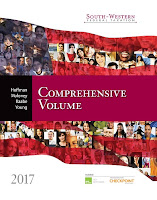Search This Blog
Chapter 8 Depreciation, Cost Recovery, Amortization, And Depletion
Discussion Questions
1. LO.1 Discuss whether property that is classified as personal use is subject to cost recovery.
2. LO.1 Discuss the difference between personal property and personal use property.
3. LO.1 Discuss whether land improvements are eligible for cost recovery.
4. LO.2 At the beginning of the current year, Henry purchased a ski resort for $10 million.
Henry does not own the land on which the resort is located. The Federal government owns the land, and Henry has the right to operate the resort on the land pursuant to Special Use Permits, which are terminable at will by the Federal government, and Term Special Use Permits, which allow the land to be used for a fixed number of years.
In preparing the income tax return for the current year, Henry properly allocated $2 million of the purchase price to the costs of constructing mountain roads, slopes, and trails. Since the acquisition, Henry has spent an additional $1 million on maintaining the mountain roads, slopes, and trails. Identify the relevant tax issues for
Henry.
5. LO.2 Identify the three factors reflected in the MACRS tables when the amount of cost recovery is determined.
6. LO.2 Discuss the computation of cost recovery in the year an asset is placed in service when the mid-quarter convention is being used.
7. LO.2 Discuss the computation of cost recovery in the year of sale of an asset when the mid-quarter convention is being used.
8. LO.2 Robert purchased and placed in service $100,000 of 7-year class assets on
August 10 of the current year. He also purchased and placed in service $500,000 of 5-year class assets on November 15 of the current year. He does not claim any available additional first-year depreciation. If Robert elects to use the
MACRS straight-line method of cost recovery on the 7-year class assets, discuss the calculation of cost recovery for the 5-year class assets.
9. LO.2 Jim owns a very large ranch. A large part of his business is the production and raising of breeding cattle. Jim understands that he is entitled to use
MACRS cost recovery on breeding cattle. Identify the relevant tax issues for Jim with respect to taking cost recovery on his self-produced breeding cattle.
10. LO.3 Discuss when § 179 expense must be recaptured.
11. LO.3 Explain how the § 179 limited expensing deduction affects the computation of MACRS cost recovery.
12. LO.3 Discuss the treatment of a § 179 expensing carryforward.
13. LO.3 Discuss the definition of taxable income as it is used in limiting the § 179 expensing amount.
14. LO.2, 3 A professional consulting business sells professional tools and equipment and provides associated services, such as repair and maintenance, to its customer base. The company’s employees include technicians, who are required to provide and maintain their own tools and equipment for performing the repairs and maintenance work. The company will reimburse a technician for amounts spent to purchase tools and equipment eligible for a § 179 deduction up to a set amount each year. Any costs for tools and equipment that exceed the set amount will not be reimbursed.
John is a technician for the company. During the current year, he purchased equipment that qualifies for the § 179 deduction. John paid $50,000 for the equipment and was reimbursed the set amount of $40,000. Identify the relevant tax issues for John with respect to § 179 and the computation of his taxable income.
15. LO.4 Discuss how the limits on cost recovery apply to listed property.
16. LO.4 Discuss the tax consequences if the business use percentage of listed property falls to 50% or lower after the year the property is placed in service.
17. LO.7 Explain the amortization period of a § 197 intangible if the actual useful life is less than 15 years.
18. LO.7 Harold and Bart own 75% of the stock of Orange Motors. The other 25% of the stock is owned by Jeb. Orange Motors entered into an agreement with
Harold and Bart to acquire all of their Orange stock.
In addition, Harold and Bart signed a noncompete agreement with Orange Motors.
Under the terms of the noncompete agreement, Orange will pay Harold and Bart $15,000 each per year for four years. Identify the relevant tax issues for Orange Motors.
19. LO.7 In May 2016, George began searching for a trade or business to acquire. In anticipation of finding a suitable aquisition, George hired an investment banker to evaluate three potential businesses. He also hired a law firm to begin drafting regulatory approval documents for a target company. Eventually, George decided to purchase all of the assets of Brash Corporation. Brash and George entered into an acquisition agreement on December 1, 2016. Identify the relevant tax issues for George.
20. LO.8 Discuss how the cost ofmineral rights enters into the calculation of cost depletion.
